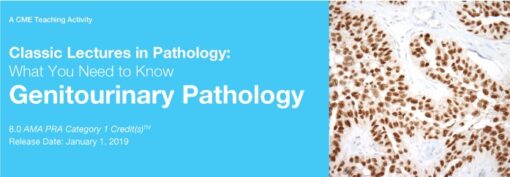2019 Classic Lectures in Pathology: What You Need to Know: Genitourinary Pathology
$30.00
This Product is shared via google drive download link, So please share your correct Gmail id while placing the order .Please note that there are no CME points or certificate associated with this course Samples for Courses Can be found here : Free Samples Here!
Categories: Courses, Obstetrics & Gynecology COURSES, Pathology courses, Urology
Tags: Obstetrics & Gynecology COURSES, Pathology, Urology
2019 Classic Lectures in Pathology: What You Need to Know: Genitourinary Pathology
About This CME Teaching Activity
2019 Classic Lectures in Pathology: What You Need to Know: Genitourinary Pathology This CME Activity offers a practical review of genitourinary pathology combining basic to advanced techniques, pearls and pitfalls to pathologic diagnosis and case reviews.
Target Audience
This CME activity is intended and designed to educate pathologists.
Educational Objectives
- At the completion of this CME teaching activity, you should be able to:
- Employ the diagnostic approach to assessing difficult prostate needle biopsy specimen.
- Explain the nomenclature and diagnostic approach to flat and papillary lesions of the urinary bladder.
- Describe the newest classification of renal tumors.
- Understand and apply the International Society of Urologic Pathology WHO Gleason grading guidelines for prostate cancer.
- Be aware of and be able to diagnose newly recognized tumors of the kidney.
- Describe the importance of key pathologic parameters in the management of patients with T1 bladder cancer.
- Discuss the importance of key pathologic parameters in the management of patients with T1 bladder cancer.
TOPICS
Session 1
- A Contemporary Approach to Prostate Pathology
- Michelle S. Hirsch, M.D., Ph.D.
- Updates in Renal Epithelial Neoplasia
- Michelle S. Hirsch, M.D., Ph.D.
Session 2
- A Practical Approach to the Use of Biomarkers in Genitourinary Pathology
- Michelle S. Hirsch, M.D., Ph.D.
- Diagnostic Approach to Difficult Prostate Needle Biopsies
- Ming Zhou, M.D., Ph.D.
Session 3
- Diagnostic Approach to Flat and Papillary Urothelial Lesion
- Ming Zhou, M.D., Ph.D.
- Pattern Based Approach to Diagnosis and Classification of Renal Tumors
- Ming Zhou, M.D., Ph.D.
- The Critical Role of the Pathologist in the Management of Bladder Cancer
- David J. Grignon, M.D., FRCP(C)
Session 4
- Reporting of Prostate Cancer in Needle Biopsy Specimens: Gleason Grading and More
- David J. Grignon, M.D., FRCP(C)
- The 2016 WHO Classification of Kidney Tumors: New Entities and Diagnostic Challenges
- David J. Grignon, M.D., FRCP(C)
- Release Date: 01/01/19
Related products
Courses
$40.00
$20.00
$5.00 – $25.00Price range: $5.00 through $25.00
Anesthesiology & pain medicine
2022 International Liver Transplant Society Annual Congress (ILTS) (Videos)
$30.00
Courses
$30.00
$30.00
Anesthesiology & pain medicine
$45.00
$40.00











